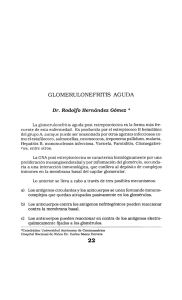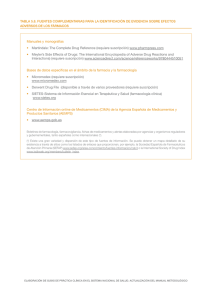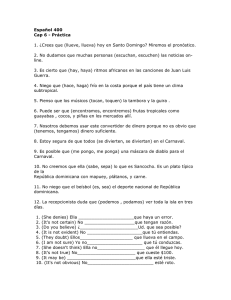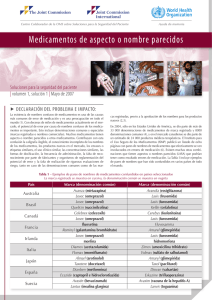Exposición Dr. Juan Antonio Rodríguez Portas
Anuncio
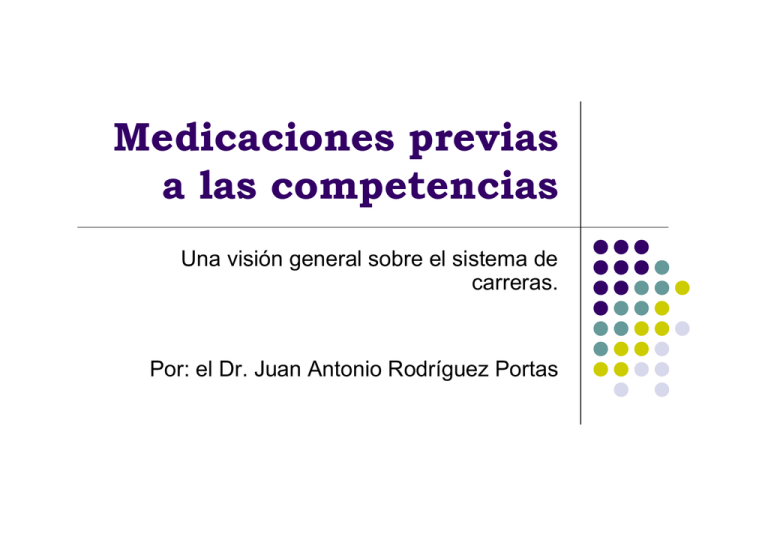
Medicaciones previas a las competencias Una visión general sobre el sistema de carreras. Por: el Dr. Juan Antonio Rodríguez Portas Sistemas de uso mundial Aquellos países que no permiten ninguna medicación en las competencias. Inglaterra, Australia, Francia, Sud África, etc. Aquellos países que permiten el uso de dos drogas la furosemida y la monofenilbutazona. Argentina, Chile, USA, Canadá Por que se decidió su autorización? El origen del uso de las medicaciones fue, una razón terapéutica legitima, con el propósito de ayudar al caballo a nivelar su performance ante el dolor y el sangrado. Un factor importante fue la idea de mantener y/o incrementar la participación de los caballos en las carreras. Al ser un mecanismo que puede utilizar todo competidor no hay ventajas deportivas en la carrera. Que drogas se permiten? En todo el mundo solo dos autorizadas Monofenilbutazona y Furosemida Aunque no debemos olvidar todas las otras drogas que por distintas causas no son motivo de sanción pero tampoco son particularmente autorizadas Utilización de Monofenilbutazona En condiciones puede usarse? En USA según la jurisdicción hay umbrales para su uso 24 hs y 48 hs antes de la carrera. En otros países no hay umbrales y en consecuencia puede utilizarse en cualquier momento , en cualquier dosificación y por cualquier vía de administración. Es en verdad una ayuda a los caballos? Probablemente no. Caballos doloridos desde el punto de vista veterinario quizás no deberían correr. Su utilización constante y el mantenimiento del ejercicio aumenta significativamente los riesgos de lesión. Enmascara lesiones. Es correcta nuestra acción como veterinarios? Al menos nuestra actitud es controversial Agotamos los recursos diagnósticos a fin de evaluar la claudicación? Utilizamos todas las herramientas posibles para solucionar el problema que origina la claudicación? No es una “solución” practica y sencilla cuando no hicimos lo anterior? Es una ayuda al sistema? En el corto plazo aparentemente si. En el mediano plazo probablemente no. En el largo plazo la probabilidad de daño es mucho mayor. Utilización de Furosemida En condiciones puede usarse? En USA se autoriza su uso no menos de cuatro horas antes de la carrera, y no mas de cuatro horas y media. Las dosis en USA son simple (5 cc) correspondiente a 250 mg. Doble (7 cc) 350 mg. y triple (10 cc) 500 mg totales. ( En verdad se autoriza desde 150 a 500 mg en la mayoría de los estados). En otros países no hay umbrales y en consecuencia puede utilizarse en cualquier dosificación. Es común que administren 2 y 3 cc. otros hasta 20 cc. (Chile). Es en verdad una ayuda a los caballos? Probablemente no. Disminuye el sangrado pero….desde el punto de vista veterinario quizás no deberían correr. Su utilización constante y el mantenimiento del ejercicio aumenta significativamente los riesgos de lesión pulmonar. Es correcta nuestra acción como veterinarios? Nuevamente creo que nuestra actitud es controversial Hace falta mayor conocimiento en este tema. Agotamos los recursos diagnósticos a fin de evaluar el sangrado? Utilizamos todas las herramientas posibles para solucionar el problema ? No es una “solución” practica y sencilla cuando no hicimos lo anterior? Es una ayuda al sistema? En el corto plazo aparentemente si. En el mediano plazo probablemente no. En el largo plazo la probabilidad de daño es mucho mayor. La disyuntiva del deporte de los reyes o popular Hay una visión purista que tiende a no utilizar ninguna medicación Puede el sistema ser eficiente sin medicaciones? La visión individual La visión del secretario de carreras La visión de la Industria En 1990 también estaban preocupados The first two finishers in the Kentucky Derby on May 5, Unbridled and Summer Squall, raced with the benefit of Lasix and will do so again Saturday in the Preakness. Then Summer Squall will skip the Belmont Stakes because the drug is banned in New York, and Unbridled will try racing without it. Last Saturday, 10 horses lined up for the $1 million Pimlico Special, the richest race run outside California so far this year. Nine of them ran on Lasix, including the first four finishers, and now Criminal Type, the winner, will run without it in the Metropolitan Handicap at Belmont on May 28. The debate over the use of Lasix, the trade name for the diuretic furosemide, has been made keener by the publication earlier this month of a study commissioned by the Jockey Club in 1988. A team of University of Pennsylvania researchers concluded that Lasix makes horses run significantly faster without necessarily stopping exercise-induced pulmonary bleeding, the condition it is prescribed to treat. Hay muchos en favor. Some horsemen, preferring anecdotal to scientific evidence, genuinely believe that Lasix is a humane and helpful bleeding treatment. Others, who routinely administer the drug to all their horses as a performance-enhancer, are lashing out at the Jockey Club's motives and the researchers' methods, both of which appear impeccable. The cooler argument from some horsemen's associations and state commissioners is that Lasix has become necessary. They say it would be impossible to stage as many races as greedy state legislatures now demand without allowing the drug. They say they must race their cheap horses more often, rather than giving them the time off to recover organically from their problems. Muchos en contra Even if the Lasix advocates are correct in saying the drug is necessary to keep the bottom level of the game churning, their argument does not explain why so many top-flight horses are suddenly running with the drug. Lasix is clearly not used just by trainers struggling to scratch out a living with low-level horses. It has moved into the highest levels of the game, where its misuse is all the more flagrant. The Pimlico Special was supposed to be the best race for older horses so far this year. Ten showed up, and nine of them ran on Lasix. Clearly, all of them are not chronic bleeders who were getting a necessary medication. The filly Gorgeous was coming off the best race of her life, a smashing victory over Bayakoa in the Apple Blossom Handicap last month, achieved without Lasix. Why did she suddenly need it? Her handlers said that a post-workout examination between the two races revealed some blood in her windpipe, just enough to warrant Lasix but not enough to keep her off the track for at least two weeks, the usual requirement for legitimate bleeders. How is the public supposed to wager with any confidence on horses who are being given a drug, for a condition they do not have, that may make them run faster? How can anyone make an intelligent wager on or against Criminal Type in the Metropolitan or Unbridled in the Belmont Stakes? Casual fans will not even know that these horses are racing without the drug, since neither the New York track program nor The Daily Racing Form sees fit to note whether a horse racing in New York has had Lasix elsewhere. The issue here is not whether Lasix alleviates bleeding, a point on which people of good will might disagree. It is why racing condones such obvious abuse of the drug in even its most important events, and why anyone should be attracted to play a game where the rules mean so little. Japón es un modelo de purismo 3. Medication and Drugs Brought into Japan a) Medication and drugs brought into Japan by persons involved with scheduled runners can not be used at JRA premises, unless tested beforehand at the Laboratory of Racing Chemistry. This includes soap, shampoo, skin protection cream, hoof oil and other substances used for the horse's care. Therefore, any such untested medication and drugs will be kept in JRA custody until after the race.b)A variety of products, such as hot and cold compress medications (poultice), massage medication, shampoo, and nutrient additives that are comparatively in wide use in foreign countries are available. This includes soap, shampoo, skin protection cream and other substances used for the horse's care. A list of these supplies is available at each JRA Representative Office. PROBLEMA O UNA GRAN OPORTUNIDAD? Cuanto hay para perder? Cuanto hay para mejorar y evolucionar? Velocidad de los cambios Debería, si se decide el cambio hacerse a través de un programa Decisiones rápidas, no consensuadas serán de riesgo para el sistema Dicho programa debería ser de 3 a 5 años Elementos a considerar Creencias y suposiciones, que evidencias tenemos? Programación de las carreras Modelos de entrenamiento Condiciones de las pistas Alojamiento de los caballos Alimentación Tecnología diagnostica
